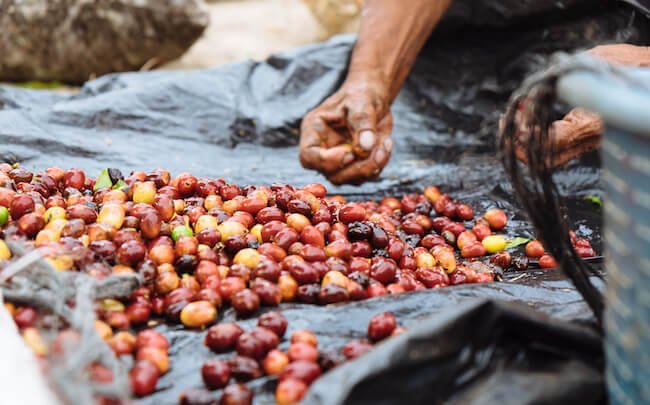Most people have a fascination with the extreme. And personally, I can’t blame them.
I also want to know which building is the tallest in the world, and what kind of chili pepper is the spiciest.
Unfortunately, reality is often way more complex than your average internet-clickbait-site will have you believe.
Still, I think it’s possible to find the answer to the question everybody has pondered sooner or later:
What is really the best coffee in the world?
In this article, I’ll dive into that rabbit hole. And I will come back up to the surface equipped with plenty of statistics to back up my claims.
Have you ever heard the term ‘coffee geek’? Well, this post is not for those vanilla guys.
This is for the ‘coffee aspie’.
If you want to know what the best coffee bean in the world truly is then read on. Below is the TL;DR version. Read on, for the full analysis.
The top-rated coffee beans
#1: Panama
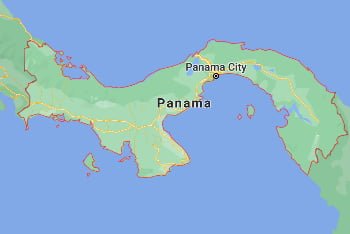
No matter how you analyze it, the rare Geisha bean from Panama comes out on top.
Panama Geisha is most frequently used among winners at the World Brewers Cup.
The rare Geisha beans are also consistently the most expensive coffee at auctions.
#2: Ethiopia
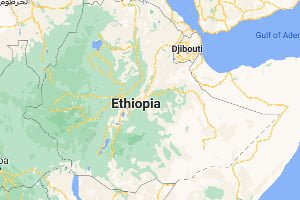
Ethiopia is right in the heels of Panama, when looking at the statistics.
This isn’t a big surprise, since Ethiopian coffee, especially the stuff from Yirgacheffe, tends to be a favorite among coffee professionals.
Ethiopian coffee has many of the same qualities as Panama Geisha but for a fraction of the price.
#3: Kenya
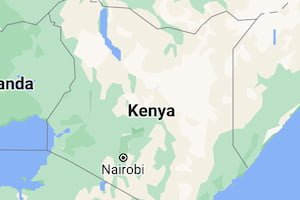
Kenyan coffee is bold but at the same time delicate. It often has flavors notes such as raspberry and blackberry.
SL 28 & 34 — the two varietals most commonly grown in the country — are high performers. On average, only Geisha coffees are scoring higher.
How did we reach our conclusions?
Going into a discourse about being the ‘best’ will always represent a challenge.
When laymen say something like: “Indonesian coffee is the best in the world”, they are being imprecise.
There’s a range of different varieties grown in that country, and the coffee can be processed in many different ways.
Not to mention, Indonesia is a vast country (It has around 16.056. islands according to the UN!), so there will be a lot of variations in terroir across places such as Java, Bali and Sumatra.
A combination of all these aspects will have a massive impact on the final flavor of a given coffee.
Most likely, Indonesia produces some lots of coffee that are extraordinary and some that are below average. So how do we quantify the output and compare it to other countries?
While, it’s interesting to see where in the world the best coffees come from country-wise, we need to be precise. As an example, it would also be nonsensical to say that ‘French wine is the best in the world’.
Clearly, there will be a gigantic difference between a generic $5 Vin de Supermarché and a bottle from the famous Chateau Lafite Rothschild.
Instead, we will have to look at a combination of all the factors below to get a meaningful understanding:
- Varietal
- Origin
- Altitude/farm
- Processing method
A quick note on subjectivity: Talking about a vague term like ‘the best’ will inevitably cause some confusion. What’s the best is obviously something that is entirely up to yourself. It’s a matter of subjective personal experience. This is an attempt to look at ‘the best’ statistically through the lens of coffee professionals.
Unfortunately, there aren’t that many statistics dealing with this specific question, so I have to be more creative.
the method
Like all serious people attempting to answer fundamental questions in the 21st century, I turn not to a guru, but to big data and statistics.
The sources
In this article I draw information from several sources. Among the most important ones are The World Barista Championship, The World Brewers Cup, and the website coffeereview.com. The Coffee Review was founded in 1997 and is operated by experienced people from the coffee industry. Since its inception, the people behind the site has blind cupped and reviewed almost 5000 different coffees.
By studying this data, I believe we can get a good idea what kind of coffee is the best in the world.
At coffeereview.com it’s possible to do an advanced search by combining a search query with a filter such as cupping score. By doing so, we can see how a particular kind of coffee statistically is performing at the cupping table. By calculating the percentage, we can then compare a wide range of beans.
A note on points
To be more precise in their evaluations as well as terminology, most people who work in the coffee industry use a rigid system to judge quality. Beans are cupped under a strict protocol and subsequently scored on a scale from 0 to 100. However, the extreme spectrums of the scale are rarely used. In practice, the majority of coffee lands somewhere between 60 and 90 points. If a coffee gets more than 80 points, it’s considered to be specialty coffee. A coffee scoring 90 points or more is supposed to be outstanding. Criteria such as flavor, acidity, body, and aftertaste are used. ‘But aren’t these points still pretty subjective?’ You may ask. And of course, the answer to that is yes.
The Q Grader Program
To overcome that problem, The Specialty Coffee Association and the Coffee Quality Institute have created the so-called Q Grader Program. It’s a rigorous course in sensorial analysis of coffee. (I have taken the test, you can read more about it here). In theory, all certified Q graders should score all coffee in a very similar way. To make sure that is the case, Q graders are supposed to do frequent ‘calibrations’ with their peers where they cup coffee and agree on a ‘baseline.’ Even though cupping scores are far from perfect, they can help us in determining what kind of coffee is the best in the world.
A bias in the scores
Usually, scoring less than 90 doesn’t mean that a bean is inferior. On the contrary; 85 to 89 is customarily considered premium quality.
But when we look at the data from coffeereview.com, it’s clear that all the conventional varieties are consistently scoring above 90. This leaves us with a couple of different explanations:
- Roasters are submitting their best coffee only. This leads to high scores
- The cuppers at coffeereview.com are more generous in their ratings compared to most Q graders.
It’s likely that both explanations are true to a certain degree. For a better real-world correlation you might want to deduct 5 points. But for the aim of this article it’s not a big problem. After all, all the beans reviewed will have a similar ‘positive’ bias.
Best coffee country

Looking at coffee countries from the perspective of quality is eye-opening. Most people will already have some notions of what constitutes ‘the best origin’ and this data seems to back up the general consensus.
Not surprisingly, Panama comes out ahead with 29 samples placed in the 96 or above position. This isn’t that strange since the majority of the prestigious Geisha varietal is grown in this small Central American country.
Following right in the heels are Ethiopia and Kenya with 28 and 27 top scoring coffees respectively.
These are the two major countries of African coffee, and they are both renowned for producing quality.
The biggest surprise is to see that Hawaii is placed as number 4. While Kona coffee is generally seen as good (albeit overpriced!) it’s rarely exported to Europe. Instead, there is a big market for Hawaiian coffee in Japan, and of course, in the US. Since this is where a lot of the roasters who submit samples to Coffee Review are based, there is most likely some kind of bias in the data.
Read More — The Best Coffee Country: Panama
Read More — Runner Up: Ethiopia

Brazilian coffee is about quantity and not quality according to the data (Fernando Mafra | Source)
BRAZIL IS LACKING QUALITY
The following countries on the list with four top-scoring samples are Colombia and Indonesia.
Both these countries export huge quantities; the former being more famous for quality than the latter. If we just go by this data that is slightly unjust.
A bunch of esteemed coffee countries have never managed to get any samples in the top position so far.
It’s interesting to note that the two biggest producing nations in the world, Brazil, and Vietnam, are included in this ‘hall of shame.’ So are smaller origins like Peru, Bolivia, Mexico, Burundi and Papua New Guinea.
The conclusion, according to this list, is that you have to focus on the “Big 3”; Panama, Ethiopia, and Kenya, if you want to source the best coffee in the world as they are far ahead of all the other origins, when it comes to producing standout coffees.
Read More: Is Brazilian coffee overrated or underrated?
Best tasting coffee type

When it comes to variety one thing is immediately clear: Geisha is superior. Almost 18% of the submitted samples of this varietal landed in a cupping score range of 96-100. Across the board, it outperforms all the other varieties; It has more samples in the top and fewer in the bottom.
Other interesting findings:
- The varietal Pacamara is sometimes compared to Geisha but in this study only 2.22% of the cupped beans managed to get the highest score. The two Kenyan varieties SL28 & SL34 managed to score significantly higher, and Bourbon also beat it narrowly with 2.38%.
- Another interesting trend to notice is that Typica seems to have more quality issues than other varieties. More than every fifth submitted Typica sample scored under 89 points. This is quite bad – even when we compare to other bread-and-butter specialty coffee beans such as Caturra, Catuai and Bourbon.
- It would be interesting to focus more on Ethiopian coffee in this section, but even though coffee from this country is generally called ‘heirloom’ it’s not considered to be a single genetic variety by agricultural scientists.
Geisha from Colombia is available on Amazon
the top rated coffee producers
Like I have mentioned before, comparing countries and varities is a bit like comparing apple pies and oranges.
So let’s try to be a bit more specific in our analysis. Let’s look at the producer level. While there are many famous coffee farms in the world, there are two coffee estates that tower above the rest:
- Hacienda La Esmeralda
- Ninety Plus
The geisha revolution
Hacienda La Esmeralda is a farm whose history is interwoven with the varietal Geisha.
Geisha had initially been found in the Ethiopian forrest region of Gesha (sic). In the 1930’s it had been brought to Kenya and Tanzania in an attempt to grow more disease-resistant crops. In the 1950’s it arrived in Costa Rica and a decade later in Panama. You can read the whole story about Geisha coffee here.
In its new surroundings, however, the plant was quickly forgotten, and it lived on in obscurity for years. That changed in 2004 when the family owning Hacienda La Esmeralda in Panama re-discovered the varietal by coincidence.
The second estate worth mentioning is Ninety Plus, which is also based in Panama (the company, however, also sources in Ethiopia). The name is a reference to the high scores the coffees are supposed to achieve at the cupping table.
Ninety Plus has really made a brand name for itself by supplying coffee to a range of the recent World Brewers Cup winners.

The best tasting quality coffee
These two estates have had almost the same amount of samples submitted to Coffee Reviews; 52 and 51, respectively.
When analyzing the distribution of scores, it becomes apparent right away that both companies produce exceptional coffee. 81% of Ninety Plus’ coffee scored 93 or above, while the number for la Esmeralda was 84%. The total average of all samples submitted to Coffee Review scoring 93 or above was only 30%.
A staggering 22% of the tested coffees from La Esmeralda even scored between 96-100. For Ninety Plus the total number was 14%. It should be noted that these stats include the Ninety Plus coffees from Ethiopia. If we filter out the African beans and just look at the brand’s coffee from Panama it’s actually a stalemate between the two elite producers.
For the average coffee the result is only 1.77%.
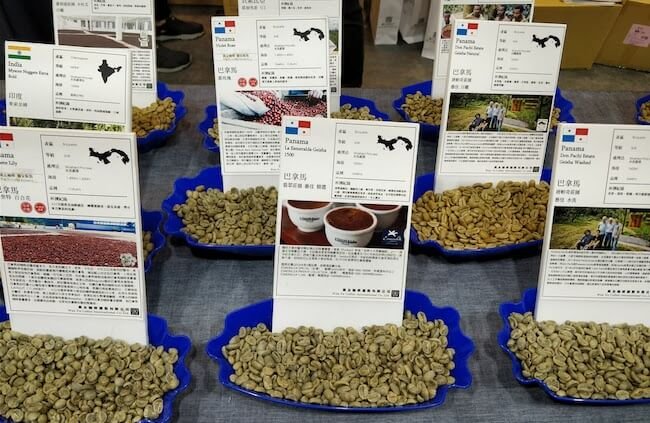
A selection of Panamanian coffee at the Taipei Coffee Expo (Source)
Go deeper: The best whole bean coffee
Take a closer look at the statistics in the boxes below. Please note, that all these stats are gathered and structured by myself and that they are my personal interpretation of the data from Coffee Review. Any errors are my responsibility solely. Please also note that this is an ‘inquiry’ and not an actual scientific study.
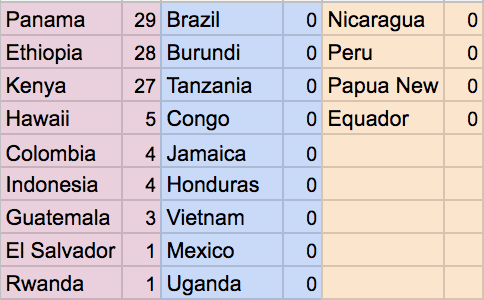
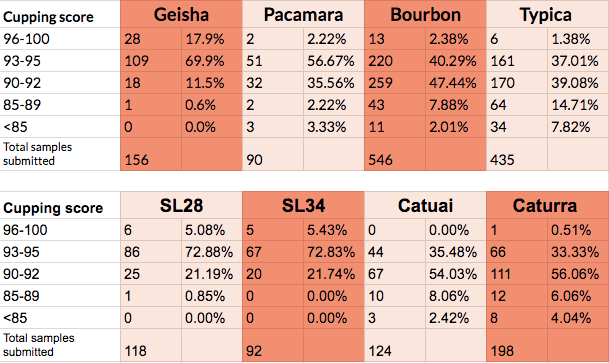
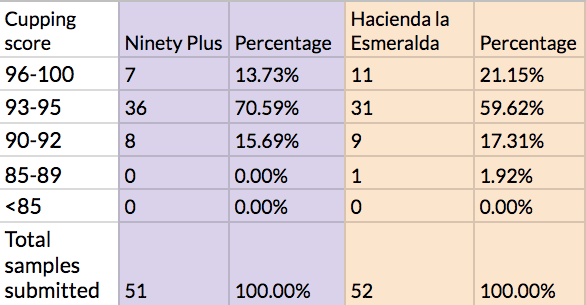
Kopi Luwak vs Geisha vs Average

Kopi Luwak vs. Geisha
A surprising number of people outside the coffee industry believe in the kopi luwak myth. The story goes like this: The best and most expensive coffee in the world is produced by collecting the dung of a coffee cherry-eating animal named the Asian Palm Civet.
In fact, kopi luwak is pointless animal cruelty. Caffeine affects the civets the same way it affects humans. And too much is not good for anybody. The animals are trapped in small cages and are force-fed just to meet the demand of gullible tourists, who think it’s actually good coffee.
So how does the kopi luwak coffee compare to ‘real’ top rated coffee? Not favorably, according to the stats.

In the 21 years, coffeereview.com has existed only 14 kopi luwak coffees have been submitted.
Upon closer inspection, four of these are not ‘true’ luwak coffees. Instead, they are washed premium coffees where a cultivated strain of bacteria from the Asian Palm Civet has been added during the fermentation stages to increase flavor potential.
These gimmicks don’t seem to have any effect at all. None of the submitted luwak coffees have ever made it into the coveted bracket of coffees scoring between 96-100 on Coffee Review.
On the contrary, kopi luwak on average scored lower than the common kinds of arabica coffee such as Typica, Caturra, and Catuai.
Learn More: Why Cat Poop Coffee is Shit
Competition coffee
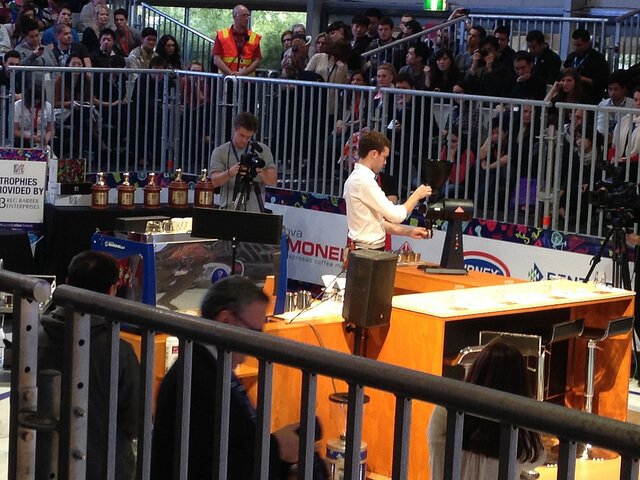
Matt Perger at the World Barista Championship (Iain | Source)
Another approach to finding ‘the best coffee in the world’ might be to look at what coffees have actually been used by the winners at the most prestigious coffee competitions in the world.
At these competitions, the flavor of the coffee only makes up one part of the score. The performance of the barista also counts. Still, when you think about it, it’s a useful way to determine what’s the best coffee in the world. The baristas at these competitions are extremely dedicated professionals – they have already beaten other skillful baristas at the national championships to qualify.
When entering the international competitions, they will often have financial support from the coffee shops they represent. They’ll be able to utilize almost any whole bean coffee that they consider the best tasting.
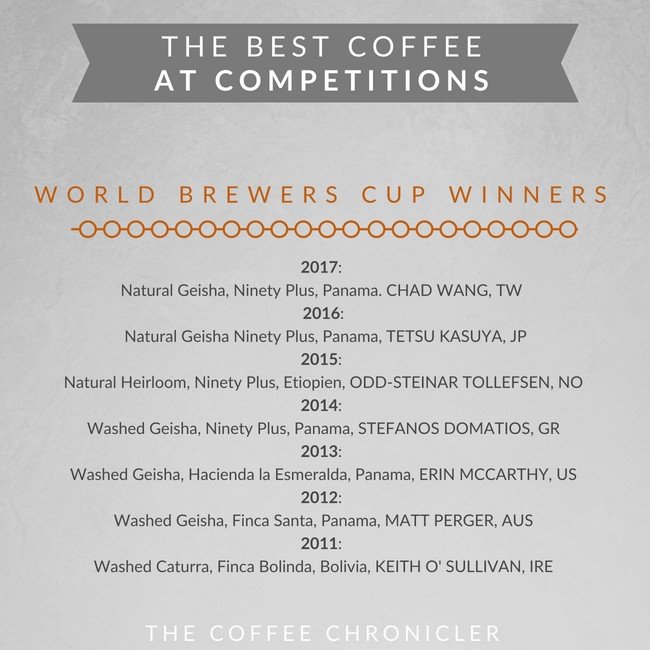
GEISHA DOMINATES – AFRICA STRUGGLES.
The results at the World Brewers Cup, where contestants duel on the ability to brew black coffee manually, are very much in alignment with the findings in the previous section.
Out of seven competitions, the winner has used Geisha in five of them. Another interesting trend to notice is that the last four years’ winners have used coffee from Ninety Plus.
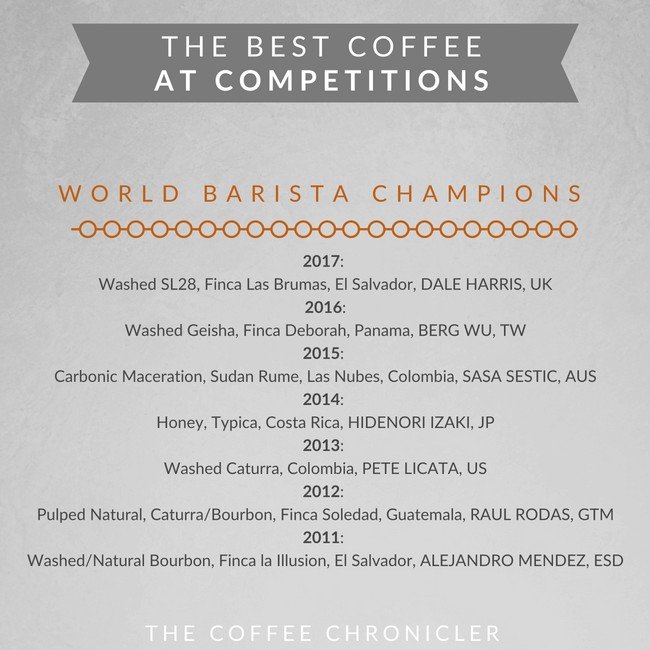
Brewing drip coffee and pulling espresso shots are two fundamentally different styles of brewing.
This is also showcased in the results at the World Barista Championship. Here we see that only the 2016 champion, Berg Wu of Taiwan, uses Geisha as the single origin beans of choice for his espresso machine.
The other winners use mostly washed coffees from Latin America.
When trying to understand the broad trends at the tournaments a couple of things stand out:
- Only one winner has used a coffee from Africa (Ethiopia)
- So far, nobody has ever won any of the top tournaments using a coffee from Asia.
- The Geisha variety is well represented with 6 out of 14 possible victories.
- The last 4 (!) winners of the World Brewers Cup have all opted for whole bean coffee from Ninety Plus.

A selection of Ninety Plus green beans (Source)
The most expensive coffee in the world
So far we’ve been looking at a lot of metrics that have to do with taste. But maybe there is a better way to assess how good coffee is? In a globalized, capitalistic world, such as ours, the market value of a particular coffee could be a useful way to determine what the ‘best coffee’ is.
So what IS the most expensive coffee in the world?
Before we get into that, let’s wait a minute and address the elephant or the civet in the room:
You have probably heard stuff like ‘kopi luwak is the most expensive coffee in the world.’ Or maybe you have googled the question and stumbled upon a listicle telling you that ‘a special elephant version’ of kopi luwak is the one.
No matter what kind of product, it holds a certain allure to be ‘the most expensive in the world.’ You are almost guaranteed free publicity, as well as a handsome profit.
Scrupulous marketeers have exploited this for ages. That’s why you see stuff like gold dipped sneakers.

AUCTION PRICES
In my opinion, the best way to judge the real value of something is to see how much informed buyers are willing to pay at an open market, where there is as little information asymmetry as possible.
That’s precisely what coffee auctions represent. For instance, most of the buyers participating in the yearly ‘Best of Panama’ auctions are professionals. They know the general market price of different varieties from different farms. The bidding history is entirely open, so they can even go back and see what cost a coffee from the same farm fetched the year before.
In my research for this article I haven’t been able to find any similar auctions selling Kopi Luwak or other ‘animal’ coffees. Sure, I have found individual retailers with shady websites selling overpriced beans, but I haven’t been able to verify that they are actually selling it to repeat customers or bulk buyers.
That leads me to categorize the claim as being the ‘most expensive coffee in the world’ as incorrect.
The real ‘most expensive’ coffee
The coffee that is generally considered (by pros) to be the most expensive one ever is a natural processed Geisha from Hacienda la Esmeralda called ‘Cañas Verdes’. It was sold for $60,100 last year on the ‘Best of Panama’ auction.
This equates to a price of 601 dollars for a pound of green coffee – the highest rate ever paid for a coffee on an auction. Before that, the record was $350 for a pound – also from Hacienda la Esmeralda.
It’s not uncommon for a green coffee to be sold for 3-4 times the price after it’s been roasted.
For instance, the Cañas Verdes, also nicknamed ‘Esmeralda 601’, was sold for $55 a cup (15 grams) by Klatch Coffee in California.
Update: At the ‘Best of Panama’ auction the 20th of July 2018 a new world record was set: $803 per pound!
The coffee was a natural processed Geisha going by the name ‘Elida Green Tip Natural’. However, this time the winner was the ‘Lamastus Family Estate’ – a farm that has been owned for a 100 years by the family of the same name.
The Lamastus Estate actually broke two records on the same evening: A lot of their washed Geisha fetched an impressive $661 pr pound.
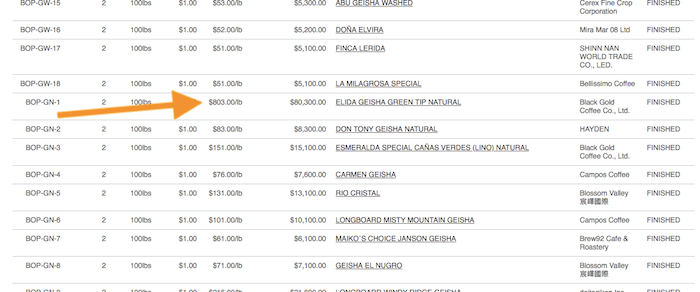
Conclusion: The best coffee beans
Looking at the ‘best coffee in the world’ debate from a more statistical side, it’s clear that Geisha from Panama generally gets extremely high scores at the cupping table.
It’s also the coffee of choice at the different coffee championships – especially Ninety Plus has been succesful during the recent decade.
Furthermore, Geisha lots from Hacienda la Esmeralda and the Lamastus Family Estate have fetched the highest prices ever paid for coffee in 2017 and 2018, respectively.
When we take all this into account, there’s only one clear conclusion:
The best coffee in the world can be found in Panama; more precisely at the Geisha farms of Ninety Plus, Hacienda la Esmeralda & the Lamastus Family.
